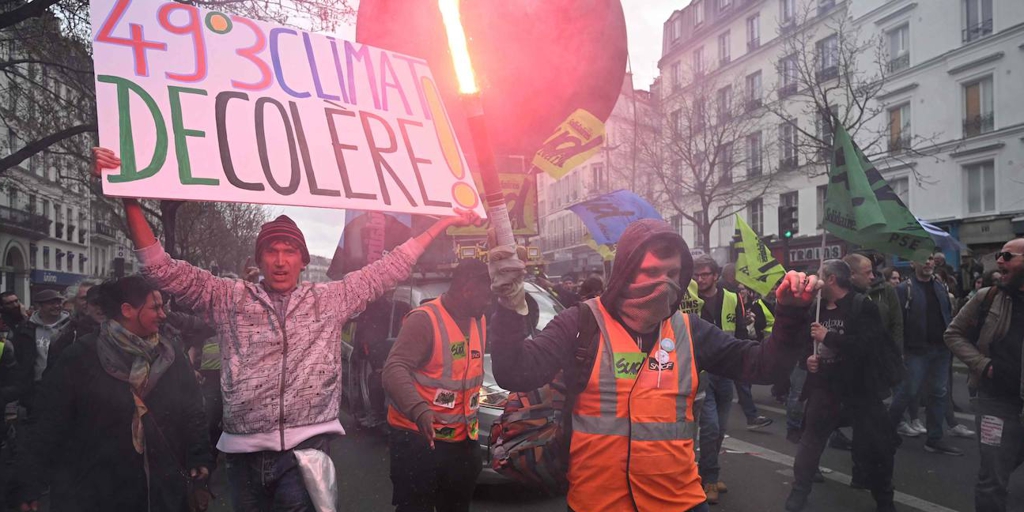
The ninth day of strikes and protests against Emmanuel Macron’s national pension system reform project, approved with a decree, without a parliamentary vote, was marked this Thursday by spectacular demonstrations throughout France, announcing a youth radicalization which sparked many violent and arson incidents in the historic heart of Paris.
Throughout all of Thursday, a rosary of nearly three hundred demonstrations, in the capital and throughout the national geography, confirmed the very substantial importance of street mobilization, with a relative rising participation. Late in the afternoon, the CGT announced 800,000 demonstrators, in Paris, and 3.5 million throughout France. The Ministry of the Interior only counted 1.08 million protesters in all of France.
Until this Thursday, the absolute record of participation was held on the day of March 7, when the unions announced 3.5 million protesters, throughout France, and when the Ministry of the Interior only counted 1.3 million. . The CGT estimates that Thursday’s day had the same massive dimension. These are important figures, but not spectacular, in a country with 68 million inhabitants.
battle of numbers
For the unions, the demonstrations on Thursday were the most important since the beginning of the crisis. For the Ministry of the Interior, on the contrary, the mobilization was higher than the day of March 23 (800,000 demonstrators), but less than the days of January 19 (1.12 million), on January 31 (1.27 million) and March 7 (1.28 million).
Beyond the traditional battle of figures, these differences in accounting criteria fail to hide some doubts about the future of the movement. The unions say they believe in the solidity and growth of the contestation, with a important student participation less than thirty years old. The Government, for its part, believes or pretends to believe in a relative stagnation. On the contrary, no one doubts a significant growth in street mobilizations, coinciding with their youthful radicalization, with many violent fringes.
In a dozen provincial cities, clashes between young radicals and law enforcement were very striking. In Paris, these confrontations were spectacular, on the Grands Boulevards that link Place de la République (an emblematic public space) and Place de l’Opéra, in front of the sumptuous building of the Opera Garnier, a national monument in the historic heart of the city. city.
The youth radicalization of the protests against the decree decided by President Macron could prolong the crisis on several fronts
Some 1,500 ultra-radical young people, according to the Ministry of the Interior, and a very similar number of riot police, staged a spectacular pitched battle, using sticks, stones, charges with tear gas and small fires that were quickly contained. A Faustian spectacle that lasted for a couple of hours, until the thousands of peaceful demonstrators were able to reach a square immortalized, since the 19th century, by Balzac and Zola, the greatest novelists of the urban history of Paris.
The very striking presence of young people in the demonstrations on Thursday suggests a possible radicalization, deeper than the protest against the reform of the national pension system. It is a response against political power, far beyond the mere reform of the national pension system. In the capital and in the provinces, young demonstrators stage a generational revolt against the President of the Republic, asking for his public head, his resignation, branded as a “murderer”, a “pretentious and ridiculous monarch” who must be led to the guillotine.Several demonstrators protest in Paris against the decree of pensions
afp
Youth radicalism contrasts with the relatively modest participation in the strikes. The private sector is simply absent from the protests. In the public sector, on the national railway network, only 25 percent of the staff participated in the strike. More than enough to cause disturbances. But insufficient to paralyze France. In teaching and health, the strike was followed by less than 30 percent of the staff. In the refineries, strategic sector, between 15 and 29 percent of strikers have managed to create serious fuel distribution problems, fueling fears of shortages at gas stations in many regions of France. In Paris, the garbage collectors’ strike has become a stinking symbol of a serious national crisis, with growing economic repercussions, deteriorating France’s image in the world, and deeply disturbing the European Union (EU).
The fronts of the crisis
The youth radicalization of the protests against the decree decided by President Macron could prolong the crisis on several fronts.
The unions are determined to prolong their test of strength, always asking for the complete withdrawal of the bill. The CGT and the CFDT, the most important unions, agree on the same analysis, but discuss the different modalities of the contestation.
In the public sector, on the national railway network, only 25 percent of the staff participated in the strike
On the political front, the left have filed an appeal against the bill before the Constitutional Council, considering that the decree decided by Macron “is an attack against the demands for clarity and sincerity of a parliamentary debate, answered by a majority of the society”. The Council’s response is not clear.
Government spokesmen were deathly silent on Thursday night, recalling the “law and order” policy advocated by Emmanuel Macron on Wednesday.
